A chance to think through how the visual impact of text, image, and text with image.
24 Items in this Learning Collection
Collection Object
Collection Object
Collection Object
Collection Object
Collection Object
Collection Object
Collection Object
Collection Object
Collection Object
Collection Object
Collection Object
Collection Object
Collection Object
Collection Object
Collection Object
Collection Object
Collection Object
Collection Object
Collection Object
Collection Object
Collection Object
Copyright
All Rights Reserved
()
Camel
Accession Number
1969/2.91
Title
Camel
Artist(s)
Utagawa Kuniyasu
Object Creation Date
circa 1824?
Medium & Support
color woodblock print on paper
Dimensions
14 15/16 in. x 10 1/4 in. ( 38 cm x 26 cm )
Credit Line
Museum purchase for the Paul Leroy Grigaut Memorial Collection
Label copy
During the Edo Period, Japan was secluded from diplomatic and trade relationships with other countries, with the exceptions of Korea, China, and the Netherlands. The man-made island of Deshima in Nagasaki bay (in the southwestern part of Japan, Kyûshû Island,) was the only port open for foreign contact. A type of woodblock print called Nagasaki-e became widely popular, depicting the foreign traders and exotic animals that came through the Deshima port.
In 1821, the Dutch brought a pair of female and male Arabian camels to Japan, and they were a huge sensation, eventually touring to major cities including Edo, Osaka, and Kyoto. Popular novelist Santôan Kyôzan detailed the animals’ physiognomy, diet, origins, and habitat to satisfy people’s curiosity. In this print, artist Utagawa Kuniyasu depicted the camels and entertainers who accompanied the show.
(Japanese Gallery Rotation, Spring 2009)
Subject matter
This double-leaf print depicts two camels and accompanying foreign trainers or performers in fringed clothing, with ballooning pants and dark boots. They may be from Portugal, Central Asia, or China, and have come with the pair of Arabia camels on a tour of Japan beginning in 1821, stopping in Osaka, Kyoto, and Edo, where Utagawa resided.
Some of the performers play instruments, while others tend to the camels. Above both pages is writing by calligrapher Santô Kyôden describing the camels and their trip. Exotic animal and foreigner prints such as these are typical of Nagasaki-e, depictions of trade and goods from foreign lands that came through the port of Deshima in Nagasaki Bay during the National Seclusion Policy (1639-1854).
Physical Description
This double-leaf print depicts two camels and accompanying foreign trainers or performers in fringed clothing, with ballooning pants and dark boots. Some of the performers play instruments, while others tend to the camels. Above both pages is writing by calligrapher Santô Kyôden describing the camels and their tour of Japan around 1821.
Primary Object Classification
Print
Primary Object Type
color print
Additional Object Classification(s)
schools of Japanese paintings and prints
Collection Area
Asian
Rights
If you are interested in using an image for a publication, please visit http://umma.umich.edu/request-image for more information and to fill out the online Image Rights and Reproductions Request Form.
Keywords
Ukiyo-e
1969/2.91
Title
Camel
Artist(s)
Utagawa Kuniyasu
Object Creation Date
circa 1824?
Medium & Support
color woodblock print on paper
Dimensions
14 15/16 in. x 10 1/4 in. ( 38 cm x 26 cm )
Credit Line
Museum purchase for the Paul Leroy Grigaut Memorial Collection
Label copy
During the Edo Period, Japan was secluded from diplomatic and trade relationships with other countries, with the exceptions of Korea, China, and the Netherlands. The man-made island of Deshima in Nagasaki bay (in the southwestern part of Japan, Kyûshû Island,) was the only port open for foreign contact. A type of woodblock print called Nagasaki-e became widely popular, depicting the foreign traders and exotic animals that came through the Deshima port.
In 1821, the Dutch brought a pair of female and male Arabian camels to Japan, and they were a huge sensation, eventually touring to major cities including Edo, Osaka, and Kyoto. Popular novelist Santôan Kyôzan detailed the animals’ physiognomy, diet, origins, and habitat to satisfy people’s curiosity. In this print, artist Utagawa Kuniyasu depicted the camels and entertainers who accompanied the show.
(Japanese Gallery Rotation, Spring 2009)
Subject matter
This double-leaf print depicts two camels and accompanying foreign trainers or performers in fringed clothing, with ballooning pants and dark boots. They may be from Portugal, Central Asia, or China, and have come with the pair of Arabia camels on a tour of Japan beginning in 1821, stopping in Osaka, Kyoto, and Edo, where Utagawa resided.
Some of the performers play instruments, while others tend to the camels. Above both pages is writing by calligrapher Santô Kyôden describing the camels and their trip. Exotic animal and foreigner prints such as these are typical of Nagasaki-e, depictions of trade and goods from foreign lands that came through the port of Deshima in Nagasaki Bay during the National Seclusion Policy (1639-1854).
Physical Description
This double-leaf print depicts two camels and accompanying foreign trainers or performers in fringed clothing, with ballooning pants and dark boots. Some of the performers play instruments, while others tend to the camels. Above both pages is writing by calligrapher Santô Kyôden describing the camels and their tour of Japan around 1821.
Primary Object Classification
Primary Object Type
color print
Additional Object Classification(s)
schools of Japanese paintings and prints
Collection Area
Asian
Rights
If you are interested in using an image for a publication, please visit http://umma.umich.edu/request-image for more information and to fill out the online Image Rights and Reproductions Request Form.
Keywords
Ukiyo-e
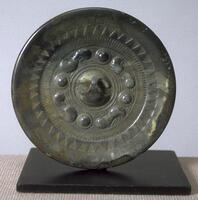
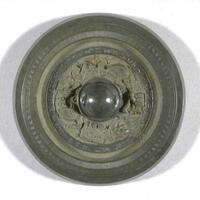






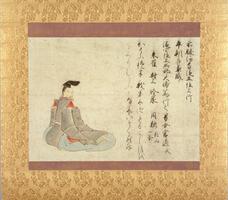
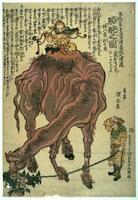

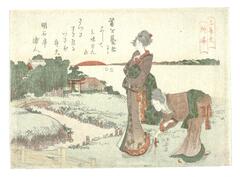
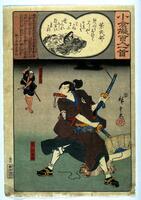



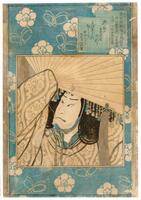
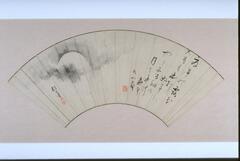

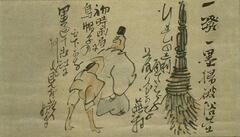

![In this monumental scroll, Nukina Kaioku has brushed a Chinese poem of his own composition, on the enduring theme of nature as refreshment for the spirit. Note his masterful variation of thick and thin strokes, wet and dry ink, stately and rapid movement.<br />The verses may be tentatively rendered into English as follows:<br /> Mandarin ducks enjoy the fresh water; their graceful forms glow as they pass through channels in the reeds.<br /> Pushing beyond the thickets [to the open pond], they call to one another again and again in the dawn.<br /> A crimson mist breaks through gaps in the glade, its glow warming hidden nests.<br /> Waking up with nothing to do, [I came here] to playfully row among the spring waves. In this monumental scroll, Nukina Kaioku has brushed a Chinese poem of his own composition, on the enduring theme of nature as refreshment for the spirit. Note his masterful variation of thick and thin strokes, wet and dry ink, stately and rapid movement.<br />The verses may be tentatively rendered into English as follows:<br /> Mandarin ducks enjoy the fresh water; their graceful forms glow as they pass through channels in the reeds.<br /> Pushing beyond the thickets [to the open pond], they call to one another again and again in the dawn.<br /> A crimson mist breaks through gaps in the glade, its glow warming hidden nests.<br /> Waking up with nothing to do, [I came here] to playfully row among the spring waves.](/media/W1siZiIsIjIwMjIvMDUvMjUvNDA4bXZmMmt5bF9kZWZhdWx0LmpwZyJdLFsicCIsInRodW1iIiwiMjQweDIwMCJdXQ?sha=1fda6bad9ec42b3f)


